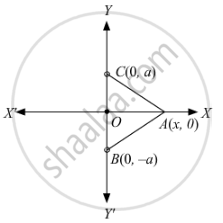Advertisements
Advertisements
प्रश्न
The base of an equilateral triangle with side 2a lies along the y-axis, such that the mid-point of the base is at the origin. Find the vertices of the triangle.
उत्तर
Let ABC be an equilateral triangle, where BC = 2a. Let A(x, 0) be the third vertex of \[∆\] ABC.

AB = BC = AC \[\Rightarrow\] \[{AB}^2 {= BC}^2 {= AC}^2\]
\[\Rightarrow a^2 + x^2 = \left( 2a \right)^2 \left( \because BC = 2a \right)\]
\[ \Rightarrow x^2 = 3 a^2 \]
\[ \Rightarrow x = \pm \sqrt{3}a\]
So, the vertices of the triangle are
APPEARS IN
संबंधित प्रश्न
Four points A (6, 3), B (−3, 5), C (4, −2) and D (x, 3x) are given in such a way that \[\frac{\Delta DBC}{\Delta ABC} = \frac{1}{2}\]. Find x.
Find the coordinates of the centre of the circle inscribed in a triangle whose vertices are (−36, 7), (20, 7) and (0, −8).
Find a point on the x-axis, which is equidistant from the points (7, 6) and (3, 4).
Find the locus of a point equidistant from the point (2, 4) and the y-axis.
A point moves so that the difference of its distances from (ae, 0) and (−ae, 0) is 2a. Prove that the equation to its locus is \[\frac{x^2}{a^2} - \frac{y^2}{b^2} = 1\]
Find the locus of a point such that the sum of its distances from (0, 2) and (0, −2) is 6.
Find the locus of a point which moves such that its distance from the origin is three times its distance from the x-axis.
A (5, 3), B (3, −2) are two fixed points; find the equation to the locus of a point P which moves so that the area of the triangle PAB is 9 units.
A rod of length l slides between two perpendicular lines. Find the locus of the point on the rod which divides it in the ratio 1 : 2.
Find the locus of the mid-point of the portion of the line x cos α + y sin α = p which is intercepted between the axes.
If O is the origin and Q is a variable point on y2 = x, find the locus of the mid-point of OQ.
What does the equation (x − a)2 + (y − b)2 = r2 become when the axes are transferred to parallel axes through the point (a − c, b)?
What does the equation (a − b) (x2 + y2) −2abx = 0 become if the origin is shifted to the point \[\left( \frac{ab}{a - b}, 0 \right)\] without rotation?
Find what the following equation become when the origin is shifted to the point (1, 1).
x2 + xy − 3x − y + 2 = 0
Find what the following equation become when the origin is shifted to the point (1, 1).
x2 − y2 − 2x +2y = 0
Find what the following equation become when the origin is shifted to the point (1, 1).
xy − y2 − x + y = 0
Find what the following equation become when the origin is shifted to the point (1, 1).
xy − x − y + 1 = 0
Find the point to which the origin should be shifted after a translation of axes so that the following equation will have no first degree terms: y2 + x2 − 4x − 8y + 3 = 0
In Q.No. 1, write the distance between the circumcentre and orthocentre of ∆OAB.
Write the coordinates of the orthocentre of the triangle formed by points (8, 0), (4, 6) and (0, 0).
Three vertices of a parallelogram, taken in order, are (−1, −6), (2, −5) and (7, 2). Write the coordinates of its fourth vertex.
If the coordinates of the sides AB and AC of ∆ABC are (3, 5) and (−3, −3), respectively, then write the length of side BC.
Write the coordinates of the circumcentre of a triangle whose centroid and orthocentre are at (3, 3) and (−3, 5), respectively.
Write the coordinates of the in-centre of the triangle with vertices at (0, 0), (5, 0) and (0, 12).
If the points (1, −1), (2, −1) and (4, −3) are the mid-points of the sides of a triangle, then write the coordinates of its centroid.
Write the area of the triangle with vertices at (a, b + c), (b, c + a) and (c, a + b).
